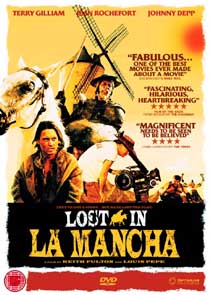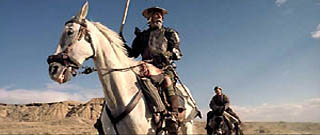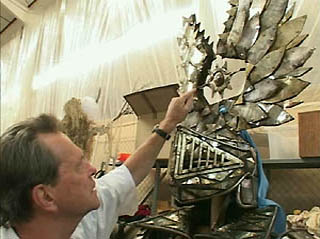 |
LOST IN LA MANCHADirectors: Keith Fulton and Louis PepeStarring: Terry Gilliam, Johnny Depp, Jean RochefortIs it possible to be a movie fan and not love the fabulous fantasy films of Terry Gilliam? I don't think so.
The documentary, created by the team which made the equally fascinating The Hamster Factor (about the making of Gilliam's Twelve Monkeys) charts the progress of the film from eight weeks before production started, until after the whole project had disintegrated, following the ill-health of Gilliam's star, the wonderful French actor Jean Rochefort. It's a stormy, emotional ride, from initial exuberance to complete despair. By the end of the documentary you might be weeping with sheer frustration. If Gilliam does not make The Man Who Killed Don Quixote it will be a real shame, a great opportunity lost; but if it does not get made because it's forever tangled up in the red tape of the insurance companies and financiers, it will be a tragedy.
The footage is often hazy, or otherwise less than perfect, but this can almost certainly be attributed to the cinéma-vérité nature of documentary filmmaking, The transfer to disc, though, has been nicely-handled, with no significant problems. The sound is Dolby Digital 2.0 (at 192kbps), although the same caveats apply to the audio that apply to the picture (Gilliam wore a microphone during filming, so at least all his dialogue is clear). There are subtitles provided for scenes where the audio is indistinct, or when members of the cast are speaking anything other than English, but no other subtitles are present, which is regrettable. The disc contains several bonus features that significantly enhance the documentary, and offer more pieces of The Man Who Killed Don Quixote jigsaw (including a few more scraps of footage from the film). There are nine deleted scenes, each a minute or two long, which include two alternate openings. Each is supported by a text introduction explaining what they represent, and why they didn't make the final cut. Other deleted scenes include the audition piece of an elderly actor who would have played one of the Spanish Inquisitors, in which he explains how it might not be possible for him to appear on horseback, because of a back injury. With hindsight it's easy to see that this should have started ringing alarm bells about the suitability of using the 70-year-old Rochfort for Quixote. A series of five Video Portraits is offered. Describing them as such is quite legitimate, but (perhaps unintentionally) misleading. They're simply relatively static, dialogue-free establishing shots of various key contributors that were shot for a stylistic approach that was ultimately dropped. One of them (a shot of Gilliam with a Quixote mask) will doubtless appear in documentaries yet to be made.
Four galleries of production stills and artwork are available, including Benjamin Fernandez' set designs, Gabriella Pescucci's costume designs, a tiny stills gallery, and Terry Gilliam's storyboards for three scenes, for the three Man Who Killed Don Quixote scenes most prominently featured in the documentary. The latter are particularly poorly presented, four-to-a-screen, and with unreadable text. Apart from the photo gallery, none of this material relates directly to the documentary, and offers a tantalising glimpse at what Gilliam's film might eventually turn out to be like. A very appealing theatrical trailer for the documentary (1'30") is offered in letterboxed format (of approx. 1.85:1). Trailers for three other Optimum Releasing projects are also offered, including one for Kurt and Courtney, which seems to be an early edit from a low-quality video source, that includes incomplete end credits.
|


 Lost
in La Mancha is a documentary about Gilliam's long-cherished dream of
making a film loosely based on Miguel de Cervantes' seventeenth century
masterpiece Don Quixote de la Mancha. The film, to be titled The
Man Who Killed Don Quixote, would have added a major twist to
Cervantes' classic story: in Gilliam's version (co-written with his Fear
and Loathing in Las Vegas collaborator Tony Grisoni) a character from the
present day (an obnoxious advertising executive, Toby Grissini, played by
Johnny Depp), sucked into the past, where a delusional old man, who's
recreating the stories of the great knights of old, mistakes him for his
colleague, Sancho Panza.
Lost
in La Mancha is a documentary about Gilliam's long-cherished dream of
making a film loosely based on Miguel de Cervantes' seventeenth century
masterpiece Don Quixote de la Mancha. The film, to be titled The
Man Who Killed Don Quixote, would have added a major twist to
Cervantes' classic story: in Gilliam's version (co-written with his Fear
and Loathing in Las Vegas collaborator Tony Grisoni) a character from the
present day (an obnoxious advertising executive, Toby Grissini, played by
Johnny Depp), sucked into the past, where a delusional old man, who's
recreating the stories of the great knights of old, mistakes him for his
colleague, Sancho Panza.
 The
UK disc, from relative newcomers Optimum Releasing, presents Fulton and
Pepe's eighty-nine minute film in full-frame (1.33:1) ratio. The project
was originally destined for use on television, in support of Gilliam's
film, so it's not surprising that this is the ratio chosen (if it had been
shot a year or two later, it would almost certainly have been shot in 16:9
format). The documentary contains a handful of priceless clips from the
footage that Gilliam managed to get in the can during the few days that
the film was in production, which are presented in what appears to be the
correct ratio (of 2.35:1), which suggests that the full-frame ratio of the
rest of the documentary is correct. The disc is dual-layered. The average
bitrate for the feature is 5.4Mb/sec. No other audio tracks are
included,
The
UK disc, from relative newcomers Optimum Releasing, presents Fulton and
Pepe's eighty-nine minute film in full-frame (1.33:1) ratio. The project
was originally destined for use on television, in support of Gilliam's
film, so it's not surprising that this is the ratio chosen (if it had been
shot a year or two later, it would almost certainly have been shot in 16:9
format). The documentary contains a handful of priceless clips from the
footage that Gilliam managed to get in the can during the few days that
the film was in production, which are presented in what appears to be the
correct ratio (of 2.35:1), which suggests that the full-frame ratio of the
rest of the documentary is correct. The disc is dual-layered. The average
bitrate for the feature is 5.4Mb/sec. No other audio tracks are
included,
 Soundbites
presents a series of six themed collections of talking heads footage,
including contributions from Gilliam and his collaborators, totaling about
half an hour. Among the topics under discussion are Gilliam's previous
attempt to raise the funds for the production (a German financier let them
down at the eleventh hour), the choice of Rochefort for the lead role, and
the eventual collapse of the 2000 attempt. Separate Terry Gilliam and
Johnny Depp interviews, especially shot for the DVD, are also offered.
Gilliam is interviewed by Mark Kermode (30m), Depp by Demetrious Matheou
(20m). After the exuberance of the Gilliam interview, the chat with the
relatively inarticulate Depp seems dry and dull, but both are worth
watching.
Soundbites
presents a series of six themed collections of talking heads footage,
including contributions from Gilliam and his collaborators, totaling about
half an hour. Among the topics under discussion are Gilliam's previous
attempt to raise the funds for the production (a German financier let them
down at the eleventh hour), the choice of Rochefort for the lead role, and
the eventual collapse of the 2000 attempt. Separate Terry Gilliam and
Johnny Depp interviews, especially shot for the DVD, are also offered.
Gilliam is interviewed by Mark Kermode (30m), Depp by Demetrious Matheou
(20m). After the exuberance of the Gilliam interview, the chat with the
relatively inarticulate Depp seems dry and dull, but both are worth
watching.